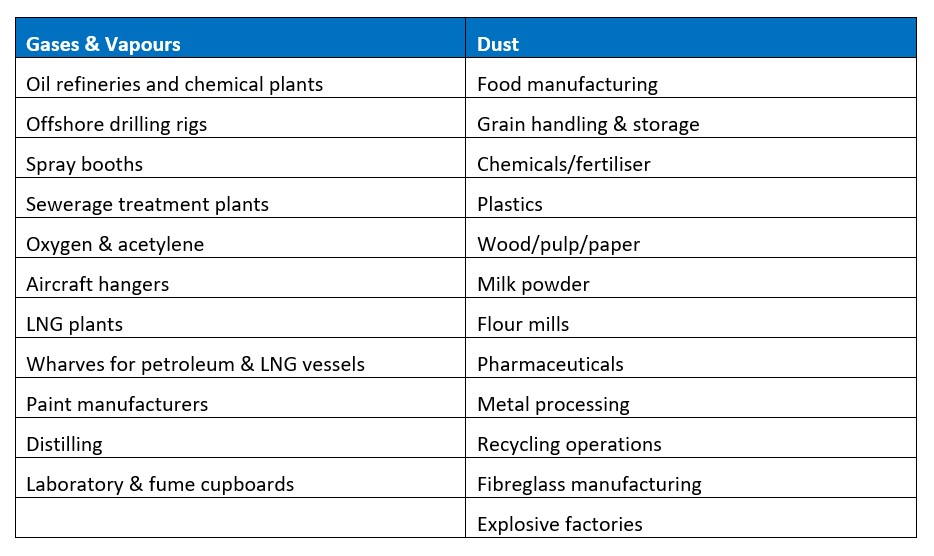Some Of Roar Solutions
Wiki Article
The 5-Second Trick For Roar Solutions
Table of ContentsEverything about Roar SolutionsIndicators on Roar Solutions You Need To KnowSome Ideas on Roar Solutions You Need To Know
In order to protect installations from a possible explosion an approach of evaluating and identifying a possibly hazardous location is needed. The objective of this is to ensure the appropriate choice and setup of equipment to ultimately stop an explosion and to guarantee safety and security of life.
(https://filesharingtalk.com/members/606050-roarsolutions)
No equipment must be installed where the surface area temperature of the equipment is higher than the ignition temperature of the given danger. Below are some usual dust unsafe and their minimal ignition temperature level. Coal Dirt 380C 225C Polythene 420C (melts) Methyl Cellulose 420C 320C Starch 460C 435C Flour 490C 340C Sugar 490C 460C Grain Dirt 510C 300C Phenolic Resin 530C > 450C Aluminium 590C > 450C PVC 700C > 450C Soot 810C 570C The probability of the threat existing in a focus high adequate to cause an ignition will certainly vary from place to place.
In order to classify this threat an installation is separated right into locations of danger depending upon the quantity of time the harmful exists. These areas are referred to as Areas. For gases and vapours and dirts and fibers there are three areas. Zone 0 Area 20 An unsafe atmosphere is very likely to be existing and may be existing for extended periods of time (> 1000 hours annually) and even continually Area 1 Area 21 A hazardous environment is feasible however unlikely to be existing for lengthy periods of time (> 10 450 C [842 F] A classification of T6 suggests the minimal ignition temperature level is > 85 C [185 F] Hazardous location electric tools maybe designed for use in greater ambient temperature levels. This would indicated on the rating plate e.g. EExe II C T3 Ta + 60C( This indicates at 60C ambient T3 will certainly not be exceeded) T1 T1, T2, T3, T4, T5, T6 T2 T2, T3, T4, T5, T6 T3 T3, T4, T5, T6 T4 T4, T5, T6 T5 T5, T6 T6 T6 A T Class score of T1 means the maximum surface area temperature level generated by the instrument at 40 C is 450 C. Presuming the connected T Class and Temperature score for the devices are appropriate for the location, you can constantly make use of a tool with a much more stringent Division rating than needed for the location. There isn't a clear response to this question. It actually does rely on the sort of devices and what repairs need to be performed. Tools with particular test procedures that can't be done in the area in order to achieve/maintain 3rd party ranking. Need to come back to the factory if it is prior to the equipment's solution. Field Fixing By Authorised Worker: Complex screening may not be required nevertheless details procedures might require to be complied with in order for the equipment to keep its third event score. Authorised workers should be used to perform the job appropriately Repair should be a like for like substitute. New element need to be taken into consideration as a direct replacement calling for no special screening of the equipment after the fixing is full. Each item of tools with a hazardous ranking need to be evaluated individually. These are detailed at a high level listed below, but also for even more comprehensive details, please refer straight to the standards.
The 10-Minute Rule for Roar Solutions
The devices register is an extensive data source of equipment documents that includes a minimum collection of areas to recognize each thing's location, technological criteria, Ex classification, age, and environmental data. The proportion of Thorough to Close inspections will be established by the Devices Risk, which is analyzed based on ignition threat (the chance of a resource of ignition versus the likelihood of a flammable environment )and the dangerous location classification( Zone 0Area 1, or 2). Applying a robust Risk-Based Examination( RBI )method is essential for making certain compliance and security in managing Electrical Tools in Hazardous Areas( EEHA).
The Buzz on Roar Solutions

In regards to eruptive threat, a hazardous location is an environment in which an explosive atmosphere is existing (or might be expected to be existing) in amounts that need special precautions for the construction, installation and use tools. high voltage courses. In this write-up we explore the obstacles encountered in the office, the risk control procedures, and the required competencies to function safely
It is an effect of modern-day life that we make, store or manage a series of gases or liquids that are regarded flammable, and a variety of dusts that are deemed flammable. These materials can, in certain problems, develop eruptive ambiences and these can have major and awful effects. Most of us are acquainted with the fire triangular remove any type of among the 3 elements and the fire can not happen, but what does this mean in the context of harmful areas? When damaging this down into its easiest terms it is essentially: a mix of a particular quantity of launch or leakage of a certain compound or material, blending with ambient oxygen, and the existence of a resource of ignition.
In the majority of instances, we can do little about the degrees of oxygen in the air, however we can have significant influence on sources of ignition, for instance electric devices. Hazardous areas are documented on the dangerous location classification drawing and are identified on-site by the triangular "EX-SPOUSE" indication. Right here, among various other crucial details, zones are divided right into 3 types depending on the danger, the possibility and duration that an eruptive environment will certainly exist; Zone 0 or 20 is considered the most dangerous and Zone 2 or 22 is considered the least.
Report this wiki page